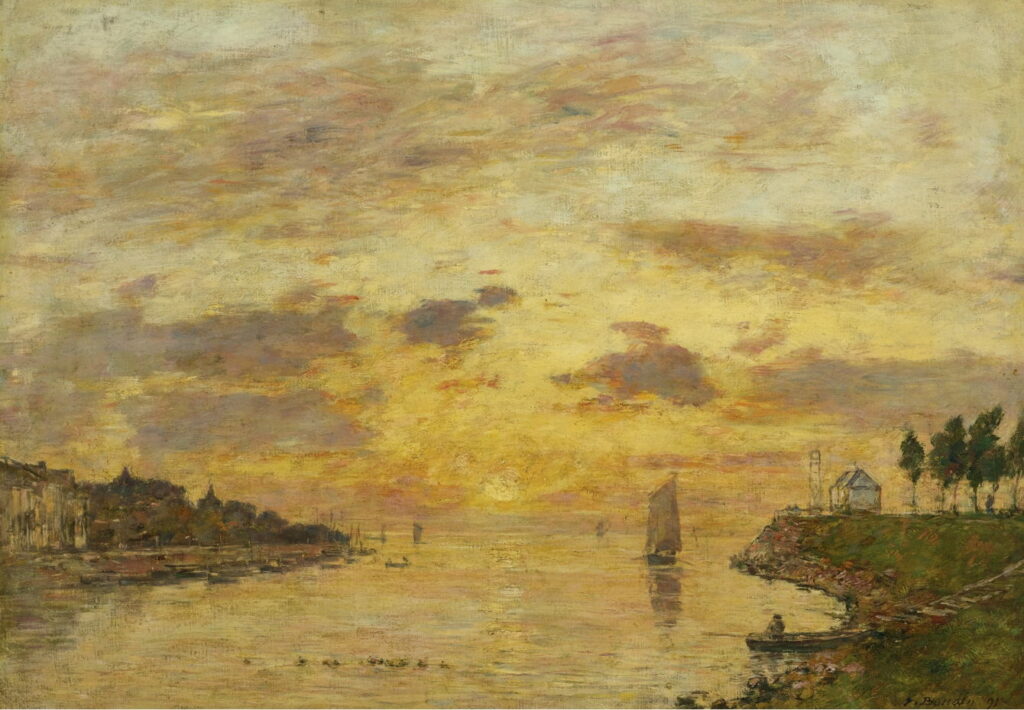Celebrating the bicentenary of Eugène Boudin: Pioneer of Impressionism 2

Two hundred years ago today, on 12 July 1824, the French artist Eugène Boudin was born. In the first of these two articles celebrating his life and work, I looked at his formative influence on French Impressionism, in particular his mentorship of the young Claude Monet. This culminated in the First Impressionist Exhibition in 1874, where Boudin showed a total of thirteen works. However, his career appeared little affected by the event, and he didn’t return to show his work at the group’s later exhibitions, instead concentrating on achieving success in the Salon, and improving his marketing.
Eugène Boudin (1824–1898), Washerwoman near Trouville (1872-76), oil on panel, 27.6 x 41.3 cm, National Gallery of Art, Washington, DC. Wikimedia Commons.
He continued to make painterly oil sketches in front of the motif, such as this of Washerwoman near Trouville from 1872-76, featuring another of his wonderful skies.
Eugène Boudin (1824–1898), Beach at Trouville (1880), oil on panel, 14.9 x 25.1 cm, Norton Simon Museum, Pasadena, CA. Wikimedia Commons.
He sketched the Beach at Trouville repeatedly. This view is from 1880.
Eugène Boudin (1824–1898), Bridge over the Touques at Trouville (1881), oil on canvas, 40 x 45.5 cm, Private collection. Wikimedia Commons.
The following year he painted this view of the Bridge over the Touques at Trouville (1881), seen at low tide. This modest river runs from Calvados to meet the Channel at Trouville. That year Paul Durand-Ruel started representing him as his dealer; two years later the Durand-Ruel Gallery staged Boudin’s first one-man exhibition in Paris, and he was also awarded a second class medal in the Salon.
Eugène Boudin (1824–1898), Ary Scheffer Place, Dordrecht (1884), oil on panel, 27 × 21.4 cm, Dordrechts Museum, Dordrecht, The Netherlands. Wikimedia Commons.
In Ary Scheffer Place, Dordrecht (1884) he sketched a more urban scene, although still with water at its heart.
Eugène Boudin (1824-1898), Parc Cordier in Trouville (c 1880-5), oil on canvas, 51 x 62 cm, Museu Nacional d’Art de Catalunya, Barcelona. Wikimedia Commons.
In Parc Cordier in Trouville (c 1880-5), under another of his masterly skies, he captures the texture of foliage particularly well. Following his early inspiration by Troyon, he painted many views of cattle and the fields immediately inland of the north French coast.
Eugène Boudin (1824–1898), Washerwomen by the River (c 1880-5), oil on panel, 26.2 × 36.2 cm, Israel Museum, Jerusalem. Wikimedia Commons.
He painted these Washerwomen by the River in about 1880-5.
In 1885, Boudin visited the south of France during the winter, and from 1890 onwards spent the winter months there, so that he could continue to paint. In 1887 his works were shown in the USA, where he was again represented by Durand-Ruel, and further exhibitions followed in France.
Eugène Boudin (1824–1898), Saint-Valery-sur-Somme. The Mouth of the Somme (1891), oil on canvas, 46 × 65.4 cm, Private Collection. Wikimedia Commons.
Saint-Valery-sur-Somme. The Mouth of the Somme (1891) is another more colourful view featuring the setting sun, further north-east along the coast from Le Havre.
Eugène Louis Boudin (1824–1898), Cliffs at Étretat (1890-94), oil on canvas, dimensions not known, Musée Malraux (MuMa), Le Havre, France. Image by Pymouss, via Wikimedia Commons.
In the early 1890s, when he was in his late sixties, Eugène Boudin became full post-Impressionist in Cliffs at Étretat (1890-94), one of several paintings he made then of the cliffs and beach.
Eugène Boudin (1824–1898), The Bay of Fourmis (1892), oil on canvas, 54.9 × 90.2 cm, Metropolitan Museum of Art, New York, NY. Wikimedia Commons.
Once he started visiting the Mediterranean coast, he painted many of its views, including The Bay of Fourmis (1892). Still unpopulated and unspoilt at that time, this is situated between Nice and Monaco, not far from the border with Italy.
Eugène Boudin (1824–1898), View of Antibes. The Quay, Morning (1893), oil on canvas, 40 × 55.2 cm, Private Collection. Wikimedia Commons.
View of Antibes. The Quay, Morning (1893) is on the Côte d’Azur between Cannes and Nice, again not far from the Italian border. High speed direct train services to this area had started back in the 1880s, opening access to artists and tourists alike.
Eugene Boudin (1824-98), Piazzetta San Marco in Venice (1895), oil on canvas, 21 x 38 cm, Private collection. WikiArt.
Boudin visited Venice several times in the 1890s. Among his paintings there is Piazzetta San Marco in Venice (1895), which adopts the same view and composition as Renoir’s earlier Doge’s Palace, Venice from 1881. This painting is sometimes mis-titled as the Piazza San Marco, which it doesn’t show. The tower is the high Campanile.
Boudin’s health deteriorated rapidly in 1898, and he died on 8 August that year. It’s estimated that he produced over 4,000 oil paintings, and over 7,000 pastels, watercolours, and drawings. But more than anything else, his art formed the basis of French Impressionism, and his friendship with Claude Monet brought some of the greatest paintings of the century.
References
Bergeret-Gourbin A-M (1996) Eugène Boudin. Peintures et Dessins. Catalogue Raisonné Musée Eugène Boudin Honfleur, Somogy Éditions d’Art. ISBN 978 2 8505 6250 1.
His latest catalogue raisonné is by R Schmit, in three main volumes, 1973, with two supplementary volumes, in 1984 and 1993, all published by Galerie Schmit, Paris.




